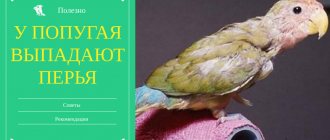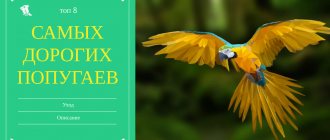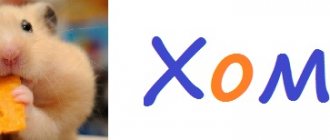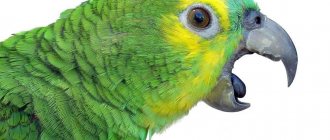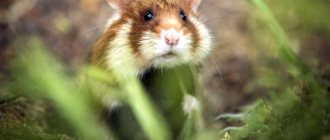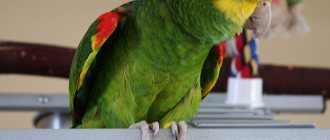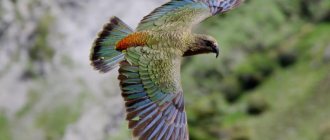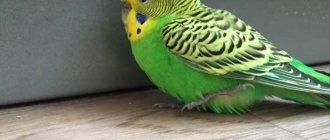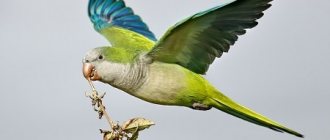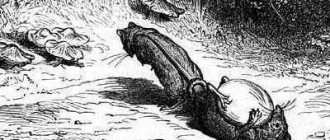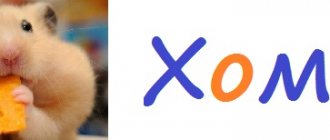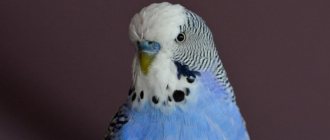Budgerigars are very clean and tidy, they spend a lot of time caring for their plumage. Sometimes the pet’s increased concern for its appearance makes the owner wonder why the parrot itches so much and plucks feathers. Strange behavior of a parrot can be associated with a psychological state or physical discomfort. If you do not stop your feathered pet in a timely manner, bare areas and even wounds may form on its body. First of all, you should understand the reasons for pulling out feathers and understand whether this is normal or pathological.
Symptoms of self-plucking
In large birds, self-plucking syndrome occurs more often than in small birds, and there is no clear explanation for this. Budgerigars also itch and bite themselves. Calmly scratching the body with beak and claws is a way to get rid of itching.
Symptoms that accompany most parrot ailments:
- the pet develops apathy and loses interest in current events;
- while awake, the bird constantly itches with varying intensity;
- inside the cage and near it there are plucked feathers, broken and deformed;
- droppings contain feather particles;
- the bird plucks those parts of the body where it can reach;
- Bald patches appear on the stomach and chest;
- In some places the damage is so severe that bleeding wounds form.
Young, growing feathers are also plucked, but this is a painful process. However, even through the pain, the parrot continues to pluck out the “stumps,” damaging the follicles. This behavior cannot be ignored - it is necessary to identify the causes and correct the emotional state of the pet.
Control measures
Self-medication can be harmful, since it is impossible to independently determine the true cause of plucking. The veterinarian prescribes the correct treatment.
After the examination, it is necessary to help the pet get rid of pain - for this you will need the necessary painkillers and anti-inflammatory medications. Based on the results of tests and examination, the veterinarian, depending on the cause of the disease, prescribes antiparasitic drugs or antibiotics. After treatment, the bird’s physical activity and mental balance are restored.
Previous
DiseasesAntibiotics for parrots
Next
DiseasesWhy is the parrot shaking or trembling and what to do
Natural Causes of Feather Loss
A domestic parrot, as well as a wild one, is characterized by partial loss of feathers. In a sense, a feather is a consumable: it has served its purpose and fallen out, and a new one has grown to replace it. In a normal lifestyle, it is clear why budgies pluck their feathers: this happens during routine cleaning, as well as during the molting process. This situation does not cause concern to the owner, as it does not lead to baldness of the birds.
Hygiene
Pet parrots have their own rituals. One of them is regular pen care. During the cleaning process, the bird takes the waxy lubricant that has protruded from the tail part with its beak, applies it to the feathers, and shakes it. The result of this procedure is shiny, dense feathers and a good mood for the parrot. With particularly intense actions, a few feathers may fall out, but this is not a big deal.
This is interesting! The budgerigar maintains the beauty and splendor of its plumage with the help of the secretion secreted by the coccygeal gland.
Shedding
Once or twice a year, birds undergo a complete change of plumage. This natural process is called molting and normally does not cause concern. Used feathers fall out spontaneously, and if this does not happen, the parrot plucks them out. New feathers gradually emerge from the follicles and at first look like tubes. Feather growth is accompanied by quite noticeable itching. At the sight of the columns appearing on the pet's head, the owner understands why his parrot plucks its feathers and actively itches. A moulting bird devotes much more time to its plumage.
Signs
The main symptoms of self-plucking include:
- apathy of the parrot, which sits on a perch with a ruffled appearance, and also refuses to communicate with the owner or other birds;
- lack of feathers on the chest, belly and wings, and in especially neglected situations the bird plucks feathers on all parts of the body except the head;
- At the bottom of the cage, pulled out feathers are found, and often the bird not only pulls them out, but also bites them, tears them, and trembles;
- if new feathers are pulled out, bleeding wounds appear on the skin.
The wavy plucks out even the smallest and newest feathers, and does this with special frenzy, so large wounds appear and blood vessels are also exposed. This leads to heavy bleeding, so the bird can become infected with other infections.
Dangerous causes of feather plucking
If a parrot voluntarily gives up its feathers outside of the molting period, it is worth considering whether the owner is properly caring for the parrot. Excessive feather plucking accompanied by changes in behavior indicates a pet illness. In addition, parrots, as intelligent creatures, often experience stress. Mental disorders mainly occur in birds living alone. Prolonged depression due to lack of communication, poor nutrition and errors in care are the minimum list of reasons for self-plucking.
Skin diseases
Parrots infected with chin mites, fluff mites or knemidocoptic mange have damaged plumage and severe itching. Parasites enter the bird's body during dust baths, as well as through untreated branches or poor-quality grain mixture. Beetle mites feed on feather particles and the epidermis. The movements of scabies mites inside the skin layer are accompanied by severe itching, as a result of which the pet scratches furiously with its claws and pecks at the body. The skin peels off and growths form on the paws and beak.
Mycoses (fungal diseases) worsen the quality of life of poultry. Several types of fungi are constantly present in the body, but they do not manifest themselves in any way. But a decrease in immunity entails the activation of fungal colonies. White discharge may appear from the beak. The parrot spreads the infection throughout its body. There are noticeable ulcers on the skin that give the bird unbearable itching.
Psychological disorders
Budgerigars are very shy and sensitive. Stress is common for them. A small bird may panic at the sight of an unusual toy, in a new or noisy environment, or at unexpected human actions. During adaptation, every little thing puts a young parrot into a state of stress. Internal tension is why the parrot plucks its feathers.
Possible causes of stress:
- change of owner or place of residence;
- transportation;
- sharp, loud sounds;
- sudden turning on of lights at night;
- emotional behavior of the owner, family members and guests;
- attack by a dog or cat;
- rough catching, an attempt to force a pet into a cage;
- the appearance of a new bird in the cage;
- A cramped cage means there is no way to fly freely.
A stressed parrot tries to escape by being distracted by its usual actions. Ordinary care of an outfit turns into thoughtless removal of feathers. The bird automatically bites and pulls out feathers, not noticing that it is exposing its body. Psychological self-plucking cannot be stopped. Some parrots become disabled - the feathers on their wings and tail stop growing.
Incorrect conditions of detention
Domestic parrots require special microclimate parameters: warm and humid air, a lot of natural light. The humidity in the room should be kept at 50-60%, but this is difficult to achieve when heating devices are running. Batteries dry out the air a lot - this is one of the reasons why budgies pluck their feathers. The bird's mucous membranes dry out, the skin loses moisture, and dandruff appears on it. Dry and tight skin itches, feathers break off at the base.
To cope with the problem of low humidity in a room, you can use any available method:
- hang wet towels on the radiators and near the cage and wet them as they dry;
- install a humidifier or air washer;
- often spray the bird with water from a spray bottle if it is not afraid of this manipulation;
- provide the parrot with access to a container of water in which to bathe.
Did you know? Water treatments refresh and soothe the skin and moisturize the bird's feathers. After bathing, you need to help your pet dry quickly so that he does not catch a cold.
Unbalanced diet
Healthy, dense, shiny plumage indicates that the parrot is eating well. A poor diet, on the contrary, worsens the condition of feathers. The basis of the poultry menu should be grains, seeds, and legumes. However, grain mixtures are not the only type of food for parrots. Cereal feed contains proteins, fats and carbohydrates, but does not contain some amino acids necessary for feather formation.
In addition to the main diet of a feathered pet, there are vegetables, fruits and herbs. These products are rich in vitamins, fiber, and microelements. Not all parrots are happy to eat succulent food, but they can be trained. There are special devices for fruits - foragers, with the help of which birds try new types of food in a playful way. If the bird refuses unfamiliar food, vitamin and mineral supplements must be introduced into the diet. They come in the form of drops, dry mixture, granules.
Eye diseases
If your pet was completely healthy, but suddenly began to blink or close his eyes frequently, try to examine his eyes closely
Pay special attention to the absence of foreign bodies: husks, sand, fluff
The speck from the eye must be removed by carefully running a clean cotton pad over the surface of the eyeball
It is quite easy to suspect inflammation: if the cockatiel parrot usually has clean and shiny eyes, then during illness they become cloudy and tears flow. The area of skin around the eyes turns red and pus is released.
Eye treatment is as follows: for treatment, use a solution of sodium sulfacyl (take three parts of water for one part of the drug) or furatsilin. Rinsing and instillation are repeated 2-3 times a day, and at night tetracycline eye ointment is placed under the eyelid.
What to do if your parrot plucks feathers?
Unusual behavior of a pet should alert the owner. This especially applies to those cases when the parrot pulls out feathers for no apparent reason. Self-plucking, which is harmless at first, can develop into a persistent habit that is difficult to break.
If the baldness is not due to seasonal shedding, the best solution is to take your parrot to the vet. At the clinic, the bird will be tested for parasites and infections. During the inspection, the specialist will diagnose the problem and select methods to eliminate it. Special ointments will get rid of ticks and bedbugs, tablets and suspensions will get rid of fungus, and complex nutritional supplements will get rid of vitamin deficiency.
Treating the effects of stress is more difficult than treating a specific disease with medications. You will have to devote all your free time to your pet: talk to him, pick him up, stroke him, offer him toys. Collars or bitter sprays will not save you from psychological self-plucking - only care and attention.
A single feather that has fallen out of a parrot is not yet a cause for alarm, but large bare areas of skin are already an advanced situation. The sooner the circumstances under which a parrot begins to pluck feathers are identified, the greater the likelihood of eliminating the problem.
Treatment methods
To help your parrot not pull out its feathers, it is recommended to spray the feathers with a special bitter composition. Beafar, sold in spray form, is considered effective. The composition contains bitter components that do not harm poultry or humans.
Additionally, you can use the natural antiseptic aloe vera , which not only tastes bitter, but also anesthetizes, stops bleeding, and also softens the skin, relieving irritation.
You can use home remedies, such as making a solution from baking soda. But in addition to using these substances, it is necessary to determine the reason why the bird plucks its feathers.
Diagnostics and therapy
Why does my budgie's feathers fall out? A similar phenomenon can occur not only in this breed. The presence of the disease can only be diagnosed in a veterinary clinic. In this case, the veterinarian can determine the presence of an allergic reaction, hormonal imbalance, bacterial disease, fungus, deficiency of nutrients and vitamins. Before visiting a specialist, a bird owner should:
- Watch the parrot carefully.
- Examine its plumage and body.
- Make your pet's diet balanced.
If there are several parrots in the house, then the sick individual must be separated from the rest. Healthy birds also need to be closely monitored and well fed.
Down-eaters
The appearance of feather eaters is one of the most likely reasons why parrots pluck their feathers. Small parasites about two mm long most often infect aviary birds, but can settle on a domestic parrot if, for example, the cage was taken out onto an open balcony.
These insects have a gnawing type of mouthparts and eat feathers and keratinized epithelium. Thanks to three pairs of legs with tenacious claws, they easily move around the parrot's body.
The appearance of lice eaters is accompanied by a number of characteristic signs:
- the parrot behaves restlessly, stops playing, eats poorly;
- the bird constantly picks and tries to tear out its feathers, itches, and becomes ruffled;
- upon closer examination, the feathers are dotted with needle-like holes, and clusters of eggs are clearly visible on them.
The yellowish-brown colored insects can be found on the back and under the wings. Female lice eaters often attach their eggs to the down around the bird's cloaca.
The following drugs are used for treatment:
aerosol insecticides: “Arpalit”, “Clandestine”, “Frontline” (use with caution, following the instructions); wormwood or chamomile in powder form is rubbed into the feathers; A 1% solution of boric acid is used as an antiseptic. The cell and all its components must be treated with disinfectants, for example, “Virosan”, “Ecocid S”
You can use boiling water or 5% iodine solution
The cell and all its components must be treated with disinfectants, for example, “Virosan”, “Ecocid S”. You can use boiling water or a 5% iodine solution.
Parasite infestation
If a budgerigar intensively loses feathers, constantly itches, pulls out feathers, or has bald patches or bald spots on its body, most likely the bird is infected with ectoparasites - scabies mites, feather eaters.
Carefully inspect your pet for fallen feathers. On them you can see traces of the vital activity of parasites. Place a white cloth and a sheet of paper on the bottom of the cage. If small black, gray, or red dots appear, the parrot is infected with a mite.
To prevent the bird from losing its plumage, if the body begins to itch severely, it must be treated immediately using preparations for general and local use (ointments, suspensions, liniments).
Dermatoses, dermatitis, mycoses
Very often, self-plucking is provoked by dermatological diseases, which affect all types of parrots without exception. Lack of vitamins, constant skin irritation, chronic pathologies, stress that weakens the body, and unfavorable indoor microclimate are predisposing factors that contribute to the development of dermatitis in birds.
Parrots become restless, sit on a perch or the bottom of the cage, ruffled, constantly itching, tearing out their feathers. Due to severe itching, wounds, scratches, and hairless areas appear on the body. The skin is hyperemic and thickened. In severe cases, the parrot can completely pluck the feathers on its wings and tail.
A veterinarian or ornithologist will tell you what can be done in such a situation after establishing the exact root cause. In some cases, it will be necessary to conduct a series of laboratory tests, based on the results of which treatment will be prescribed for your feathered pet.
Depression
Another common reason why parrots pluck feathers is basic depression.
Domesticated parrots are often purchased not only because of their magnificent appearance, but also because of their funny behavior and cheerful disposition.
These birds can have fun all day long and fly around the room, attracting your attention and responding to your reciprocity
However, as soon as you stop paying attention to them, they will immediately begin to feel sad. Surely you could see a picture more than once when a lonely bird retires into its cage and constantly dozes
However, other factors can also cause depression. Such as the death of a couple, change of place of residence, chronic lack of sleep, and even food that is unsuitable for the pet. All of this can cause your parrot to start itching and tearing out its feathers.
And if a caring owner immediately pays attention to this, he will certainly correct the current situation. An experienced breeder will not even need to explain what to do and what to do if his pet becomes depressed
Be sure to place some interesting toys near the bird’s house and inside it that the pet could play with in your absence. In addition, you will need to check the poultry feed and, if necessary, replace it with another grain composition.
How to distinguish a bird's self-plucking from its infestation by ectoparasites?
Pere-eaters
Self-nurturing of birds is never associated with feather eaters. In the presence of feather eaters, the bird may become restless, itch, and often clean its plumage, but malophages (down feather eaters) do not lead to the appearance of bare areas of the bird’s body. Bird eaters are always visible to the naked eye, and even more so with a magnifying glass.
Tick mites (Syringophilus spp.)
These mites can cause self-plucking because... The feather mites infect the developing feathers and cause a widespread inflammatory reaction. And the inflammatory reaction is always accompanied by pain. When a bird is infected with a feather mite, the development of the feather is disrupted: the feather is curved, underdeveloped, mainly the flight feathers are affected, bare areas of the bird’s body appear very rarely.
Ixodid ticks
When infected, birds may self-pluck. But more often, when a bird is massively infested with ixodid ticks, the bird does not have the physical strength to pull out the plumage. Ixodid ticks are clearly visible to the naked eye.
Read also: Constipation after rotavirus in a child
Gamasid mites
Birds are itchy and restless. But even with mass infestation by these mites, completely bare areas of the body do not appear.
Feeding porridge to adult parrots
Quote “I cook porridge (a mixture of buckwheat, rice and other grains that are on hand) and beans and corn separately in different saucepans - because... Porridge cooks quickly, but beans and corn take a long time. Yes, I almost forgot. I add a little dry oatmeal like rolled oats to the already cooked hot grains - they steam there. From the finished porridge I make pieces about the size of less than a tablespoon and place them on the kitchen board. I do the same with corn beans: I make separate piles of the same size. The board goes into the freezer. When everything has hardened, I break off pieces of porridge and legumes from the board and put them in separate dishes so that they take up less space in the freezer. This way I get pieces:
- fruits and vegetables,
- cereal porridge,
- legumes.
I defrost these pieces and feed them to the macaw. I add a dozen granules to a serving of this porridge. Why don't I mix everything at once? Because in the morning I give him mash with porridge and beans. And in the evening - more fruity. When these components are frozen separately, I can adjust the composition (although this is not necessary. You can mix everything at once). During the day I close the macaw in a cage with this porridge (for 2 hours at about 12 noon and for two hours at about 5 pm) and don’t bother it. When he began to eat it normally, he began to put the mash from the cage on the bait - now it is always available to him... But there is a danger in such mash - it must be changed to fresh no later than after 5 hours (it spoils quickly). - “Quote closed”
Building material in nests
This is the first thing that comes to mind. The basic instinct is reproduction. You need a place where the eggs will hatch and the chicks will live for the first time.
- Madagascar Greyhead.
- Green-headed (collared).
- Spectacled.
- Taranta (black-winged).
- Orangehead.
- Rosy-cheeked.
- Masked.
Collecting material to create a nest The masked lovebird has three subspecies:
Not all species build nests; some make do with a hollow in a tree. Some people are too lazy to look for a hollow; the bird makes its bedding right on the ground.
The nest is built by the female (gender discrimination...). In nature, the bird finds suitable twigs, blades of grass, leaves and drags them to the site of the future nest. Birds don’t have bags, so they have to insert “building materials” into the tail, into the feathers on the lower back. The hubby (future father of the family) more often interferes with the working female, hovering around, and some completely unreasonable ones try to pull the “decoration” out of the chosen one’s tail. Female spectacled lovebirds in nature and in captivity carry blades of grass or twigs in their beaks when building a nest.
Attracting a partner
Tags
budgie plucking why does a parrot plucking budgie so much if a parrot plucks budgies relates molting parrots groom budgie a lot When a parrot plucks a budgie plucks budgies the most budgies so budgies the most budgies can budgies need budgie budgerigars are more active too
wavy corellasymptomstypesof ownersinfectiontotallargemost
